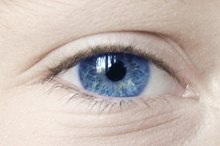What Are the Causes of Flashing Lights in the Left Eye Followed by a Headache?
Auras are visual manifestations of neurological symptoms. Flashing lights are one type of aura people report seeing, and these auras often seem to appear in either the left or the right eye. Migraines are a common cause of visual disturbances, such as flashing lights, but these uncomfortable and sometimes alarming visual symptoms can be the result of other physiological conditions as well. People who experience visual disturbances should contact their physicians immediately so any serious health problems can be ruled out or taken care of.
If you are experiencing serious medical symptoms, seek emergency treatment immediately.
Migraine with Aura
About 20 to 30 percent of people with migraines experience auras before they feel the headache pain, and some people describe seeing flashing lights that seem to appear on only one side. Visual disturbances may also manifest as jagged or wavy lines or other shapes; tunnel vision; blind spots in one or both eyes; or distorted views of objects. This can alert someone that a severe headache is about to begin, which may allow early treatment of the migraine before it reaches its peak.
While many migraine sufferers experience visual problems during the headache, others have migraines that begin with the aura, during what is called the prodromal stage. An aura may start up five to 30 minutes before the headache's onset, according to The National Headache Foundation 1.
Auras include not only visual symptoms but also aural hallucinations and other sensory distortions that may last an hour or so before fading as the headache begins. Migraine headaches can be intense and if untreated, they can last for hours or even days.
- About 20 to 30 percent of people with migraines experience auras before they feel the headache pain, and some people describe seeing flashing lights that seem to appear on only one side.
- While many migraine sufferers experience visual problems during the headache, others have migraines that begin with the aura, during what is called the prodromal stage.
Ophthalmic Migraines
What Causes Light Flashes in the Eye?
Learn More
During the migraine process, blood flow changes in the part of the brain responsible for vision may result in ophthalmic migraines that can produce visual symptoms without a headache 2. : Ophthalmic Migraine').
Auras often begin with a blind spot that has a shimmering, zig-zag light within it. Ophthalmic migraines, however, are actually harmless and only cause pain in the infrequent cases when a headache follows the aura phase.
Retinal Migraine
According to MayoClinic.com, the term "ocular migraine" is sometimes used synonymously with the medical term "retinal migraine." Retinal migraines are uncommon, afflicting people who have other symptoms of migraine and involving repeated episodes of short-term, diminishing vision or temporary blindness that may precede or occur along with a headache 34. Retinal migraines are monocular, and visual disturbances, such as flashing lights affect only one eye, not both. Retinal migraines may or may not be accompanied by headaches.
For a retinal migraine diagnosis, a person must have had at least two attacks, according to Wake Forest University School of Medicine 4. In addition, the monocular visual disturbances, called scotoma, and any loss of vision experienced must last less than an hour and be reversible and confirmed by a doctor’s examination the during attack or just after.
- According to MayoClinic.com, the term "ocular migraine" is sometimes used synonymously with the medical term "retinal migraine."
- For a retinal migraine diagnosis, a person must have had at least two attacks, according to Wake Forest University School of Medicine 4.
Vitreous Separation
Causes of a Temple Headache
Learn More
When the eye’s vitreous gel shrinks due to aging, it begins to separate from the retina by peeling away in a process called vitreous separation or vitreous detachment. During this process, the gel pulls on the retina, stimulating optical nerves and causing the person to see flashes of light on the side of either the left or right eye.
Because the tugging may cause a retinal tear, the flashes should be considered a warning sign. An ophthalmologist should examine the eye to make sure a retinal tear or detachment is not occurring.
- When the eye’s vitreous gel shrinks due to aging, it begins to separate from the retina by peeling away in a process called vitreous separation or vitreous detachment.
- During this process, the gel pulls on the retina, stimulating optical nerves and causing the person to see flashes of light on the side of either the left or right eye.
Retinal Tear or Detachment
Light flashes in one or both eyes may be early signs of an eye disease known as incipient retinal detachment. People who see flashing lights in their peripheral vision may have a retinal tear or retinal detachment. If flashing lights occur suddenly, people should contact their doctor immediately for an eye exam. Headaches seldom accompany flashing lights caused by retinal detachment.
- Light flashes in one or both eyes may be early signs of an eye disease known as incipient retinal detachment.
Related Articles
References
- Robert M. Scharf, M.D.: Ophthalmic Migraine
- MayoClinic.com: Migraine
- Pula JH, Yuen CA. Eyes and stroke: the visual aspects of cerebrovascular disease. Stroke Vasc Neurol. 2017 Jul 6;2(4):210-220. doi:10.1136/svn-2017-000079
- Prasad S, Galetta SL. Approach to the patient with acute monocular visual loss. Neurol Clin Pract. 2012 Mar;2(1):14-23. doi:10.1212/CPJ.0b013e31824cb084
- Retinal Migraine Headache. StatPearls. Updated April 20, 2019.
- American Academy of Opthalmology. Ophthalmologic Manifestations of Migraines. Dec 10, 2018.
- American Migraine Foundation. Understanding Ocular Migraine.
- International Headache Society. The International Classification of Headache Disorders 3rd Edition. Retinal Migraine. 2013.
Writer Bio
Maura Wolf's published online articles focus on women, children, parenting, non-traditional families, companion animals and mental health. A licensed psychotherapist since 2000, Wolf counsels individuals struggling with depression, anxiety, body image, parenting, aging and LGBTQ issues. Wolf has two Master of Arts degrees: in English, from San Francisco State University and in clinical psychology, from New College.







